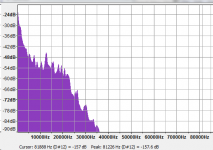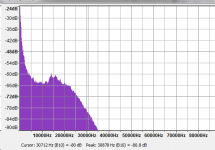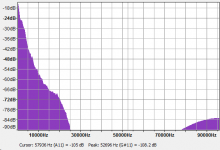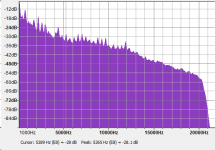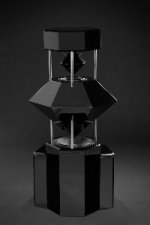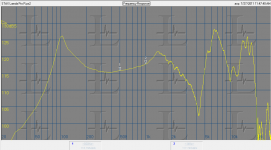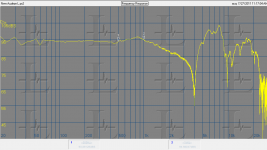I think it's the phase shift at play. I believe, right or wrong, that our hearing is rather sensitive to it, much more so than is generally believed.
Well, I have had many past experiences where a bandlimited signal somehow sounded 'brighter' or more 'crisp' by lack of better words, making it preferable to the wideband version.
It may be the phase shift, but it remains a mystery to me.
jan
Hi Jan,
We discovered this with SACD in the 90's , i think the only SACD CD's at the time that was subjectively better than standard CD's were the ones were the recordings were better ...
Do you think if 24 bit instead of 16 it would have made a difference ..?
Don't know, we only compared 24 bit versions. It is important in this kind of tests to change only ONE parameter at the time, if possible.
Agree with the recording quality being critical to perceived quality. Some music is badly recorded and it sounds bad no matter whether it comes from vinyl, CD, SACD or streaming.
Jan
Consistent with what kgrlee found in controlled testing too. I suggest you got lower IMD from decreased OOB content and preferred that.
That's an interesting suggestion.
That kind of 'brighter/crisper' is what I refer to as 'false' detail....not preferable to my ears.Well, I have had many past experiences where a bandlimited signal somehow sounded 'brighter' or more 'crisp' by lack of better words, making it preferable to the wideband version.
It may be the phase shift, but it remains a mystery to me.
jan
Similarly, I have heard low cut switched in on many integrated amps cause a subjective lump/boom in the bass.
Dan.
Last edited:
I have made the same suggestion previously........ I suggest you got lower IMD from decreased OOB content and preferred that.
I got yelled at.
Dan.
Last edited:
In an earlier test we used an FM-multiplex filter, modified, to blind test against an original and a filtered copy (15kHz lp, very steep, with 100's of degrees of phaseshift).
On that occasion most of us could reliably identify the two versions but all preferred the filtered version. Go figure.
Jan
In agree with that . Strange thing is my speakers easily go to 50 kHz and have very good dispersion . Somehow FM needs these speakers . 78's also . When I disconnect the tweeters the response is still good at 12 kHz ( 14 kHz 0dB 17 kHz - 10 dB ) . The 1926 recording I mentioned earlier would not sound identical even though statistically there should be no difference . All I think that is happening is that surface noise is part of the music and removing it is not as nice . Specifically the sound is harsher and has an obvious brick wall filter effect . That's bonkers and it is repeatable .
I have made the same suggestion previously.
I got yelled at.
Take it as a compliment, its usually a sign you're on the right track
abraxalito said:Consistent with what kgrlee found in controlled testing too. I suggest you got lower IMD from decreased OOB content and preferred that.
Or, it is just synergy: flaws in the recording hiding flaws in the gear.
Or, it is just synergy: flaws in the recording hiding flaws in the gear.
Those are not compatible.
You have too many elements that need to be verified before making judgments on the audibility of "ultrasonics". Everything from a recording that is really phase and frequency linear to above the maximum frequency of interest to speakers that have extended response and no odd dispersion aspects that would impact the testing. I would attempt to measure the frequency/phase response through the loop (sweep in recorded and replayed twice to verify the recording/replay chain). If there are issues like dispersion (a real issue above 10 KHz), phase anomalies, IM problems etc. yon are no longer sure what you are auditioning. It becomes essential to make sure you are measuring what you think you are and not a side effect.
Here are some quick spectrograms of some SD and HD recordings for comparison. The first is from Reference Recordings RR71 HRX Dance of the tumblers a 176.4 recording made with a Pacific Microsonics model 2 and Senheiser + Coles microphones. The second is from RR122 (actually a clip from pre edit and pre master). It was recorded with the same hardware. The third is from a 2L recording of Britten at 192. You can see the noise shaping in the HF boost of the noise floor. Its either an AKM or a TI ADC. The fourth is a clip from some pop that shows really extended HF energy even though its lopped off by the 44.1 sample rate. The HF is mostly synth overtones I think.
As shown there are recordings with real acoustic content above 20 KHz. Their audibility is open to question but for me the easy part is to just be faithful to the original.
Here are some quick spectrograms of some SD and HD recordings for comparison. The first is from Reference Recordings RR71 HRX Dance of the tumblers a 176.4 recording made with a Pacific Microsonics model 2 and Senheiser + Coles microphones. The second is from RR122 (actually a clip from pre edit and pre master). It was recorded with the same hardware. The third is from a 2L recording of Britten at 192. You can see the noise shaping in the HF boost of the noise floor. Its either an AKM or a TI ADC. The fourth is a clip from some pop that shows really extended HF energy even though its lopped off by the 44.1 sample rate. The HF is mostly synth overtones I think.
As shown there are recordings with real acoustic content above 20 KHz. Their audibility is open to question but for me the easy part is to just be faithful to the original.
Attachments
I read through Dr. van Mannen's paper (the English version) and it was interesting but seemed to go to the conclusions with a little too much ease for me. I would like more details on how to reproduce his tests and conclusions. The issues around audibility of ultrasonics do have validity but are not simple. A big issue is audibility of "pitch" at higher frequencies vs. envelope. And if the sensing is independent for HF than for middle frequencies (which I believe it is) any model that uses a single mechanism is going to fail.
Omnidirectional speakers trade some issues of power spectrum for others of near field reflections. For your test I would suggest having the speakers at least 10' (3M) from any wall to get the reflections outside of the Haas window. It actually makes a big difference with any speaker but even more with dipoles or omnidirectional speakers.
Omnidirectional speakers trade some issues of power spectrum for others of near field reflections. For your test I would suggest having the speakers at least 10' (3M) from any wall to get the reflections outside of the Haas window. It actually makes a big difference with any speaker but even more with dipoles or omnidirectional speakers.
Verifying high frequency response on headphones is far more problematic than speakers. No coupler I know of is accurate or useful above 8 KHz. You can float a microphone in front of the driver to get a sense for its response but its not a verifiable indication of the response in your ear. The cavity has a lot of resonance and other aspects that make meaningful response above 8 KHz just guesswork.
even the repeatability is poor at high freq with repeated re positioning even aiming for nominally the same by feel or casual eyeball tolerance on dummy head/coupler:
Expert Tests InnerFidelity's Headphone Measurement Repeatability and Reproducibility Page 2 | InnerFidelity
pad compliance, creep - do you have hair?, a pulse? - lots of issues but it turns out that headphone listening is a lot more resolving in phase and IATD tests than speakers in rooms
Expert Tests InnerFidelity's Headphone Measurement Repeatability and Reproducibility Page 2 | InnerFidelity
pad compliance, creep - do you have hair?, a pulse? - lots of issues but it turns out that headphone listening is a lot more resolving in phase and IATD tests than speakers in rooms
Last edited:
Fine for below about 1 KHz. Useless above. I normally use a fixture made from 1" plex that has flush flat surfaces. I get the best repeatability (what I need) but accuracy above 5 KHz is questionable and they all have several really strong resonances between 8 and 15 KHz. The measurements below are of two open back headphones and the both show a rapid rolloff at 20 KHz (not the microphone!) and several suckouts which are a reality of the fixture and process.
Attachments
- Status
- Not open for further replies.
- Home
- Member Areas
- The Lounge
- Sound Quality Vs. Measurements
